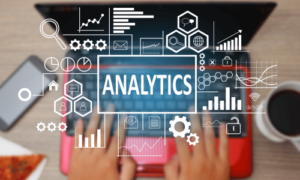
Unlocking Success with Business Analytics and Data-Driven Strategies
In today’s fiercely competitive digital landscape, data reigns supreme, and businesses that harness the power of business analytics and big data gain a strategic advantage. These organizations understand that data provides unparalleled visibility into operations, customer behaviour, and market trends. When collected, analyzed, and interpreted effectively, data becomes a wellspring of invaluable insights that drive informed decision-making and set businesses apart from the competition. Let’s delve into the world of business analytics, data interpretation, and the transformation into data-driven organizations.
Business Analytics Unveiled

Business analytics is the art and science of collecting, organizing, analyzing, and leveraging data to optimize business performance. Its primary mission is to provide data-driven answers to crucial questions that steer an organization’s course, such as:
How can we enhance efficiency and productivity?
Where are opportunities to reduce costs and overhead?
How can we improve product or service quality?
What decisions and forecasts make the most economic sense?
Who are our most valuable customers, and how can we tailor our offerings to specific segments?
What innovative products or features will resonate with customers?
How can we mitigate risks and fuel growth?
In today’s data-rich environment, analytics shines as a beacon for strategic insights.
Types of Business Analytics

Business analytics encompasses several core types, each serving distinct purposes:
Descriptive Analytics: This type paints a picture of past events by describing historical data trends and occurrences.
Diagnostic Analytics: Delving deeper, diagnostic analytics explores causality, identifying why specific events happened, and thus understanding the cause-and-effect relationships.
Predictive Analytics: Leveraging data models and forecasting techniques, predictive analytics peers into the future, projecting likely outcomes based on historical data patterns.
Prescriptive Analytics: The pinnacle of analytics, prescriptive analytics not only predicts future scenarios but also prescribes precise actions to achieve desired outcomes.
A myriad of tools, including dashboards, queries, reports, and data visualizations, empower users to perform these types of analysis. These tools, whether providing high-level summaries or detailed insights, guide decision-making.
Data Collection and Organization

The foundation of insightful analysis rests upon comprehensive, accurate data collected from all relevant sources. Data inputs may span various domains:
Operational Data: Such as production volumes, inventory, supply chain flows, equipment sensor data, and warehousing information.
Customer Data: Including sales transactions, leads, engagement metrics, demographics, and sentiment analysis.
Marketing Data: Covering website analytics, conversion rates, campaign response rates, traffic sources, and sales funnels.
Financial Data: Encompassing pricing, revenues, margins, expenses, cash flow, and accounts receivable/payable.
External Data: Comprising market research, industry statistics, economic indicators, competitor activities, and regulatory changes.
Crucially, data must be organized meticulously. It may necessitate cleaning, formatting, sorting, and cataloguing in databases to be usable. Establishing consistent schemas, tags, definitions, and standards ensures interoperability, as the quality of insights depends on the quality of data inputs.
Tools and Methods for Analysis

A multitude of tools, from the basic to the advanced, support business analytics endeavours:
Spreadsheets: These versatile tools, like Microsoft Excel, provide familiar data tables. They offer functions such as pivot tables, formulas, and charts for analysis and visualization.
Business Intelligence (BI) Software: Robust platforms like Tableau, Microsoft Power BI, and Qlik specialize in advanced interactive data visualization, featuring dynamic dashboards and reports.
Data Mining: This field utilizes machine learning algorithms to dissect large, complex datasets, revealing meaningful patterns, trends, and relationships.
SQL (Structured Query Language): SQL empowers users to access and manipulate relational databases, performing tailored queries for specific data insights.
Statistical Analysis: Leveraging statistical methods such as mean, median, standard deviation, correlations, and regression, organizations interpret data sets with precision.
Data Modeling: Creating data-driven simulations of business processes, financials, and other aspects of operations allows for the exploration of possible outcomes.
Surveys and Interviews: Direct engagement with customers and employees through surveys and interviews yields qualitative data that complements quantitative analytics.
The selection of tools depends on the organization’s goals, the nature of the data, and the capabilities of the team. Often, a combination of tools provides the most comprehensive insights.
Deriving Strategic Insights

Highly skilled analysts transform raw data into meaningful insights that drive informed, strategic decisions. They achieve this through various methods:
Identifying Trends and Patterns: Analysts spot correlations, trajectories, sentiment changes, recurring events, seasonality, outliers, and more to guide future planning.
Benchmarking: By comparing performance metrics against industry averages, competitors, and internal goals, organizations gain insights into their strengths and weaknesses.
Audience Segmentation: Grouping customers, prospects, and data sets based on common attributes, such as demographics or behaviours, reveals differences in needs.
Scenario Exploration: Using “what-if” scenarios, organizations model potential impacts of strategic changes, such as introducing new product lines or altering supplier relationships.
Hypothesis Testing: Data-driven experiments help evaluate the effectiveness of proposed changes in strategy or operations.
Causal Relationship Analysis: By examining the effects that clearly result from identifiable root causes, organizations can address issues at the source.
Risk vs. Reward Assessment: Utilizing data models, organizations quantify the probabilities and business impacts of various options under consideration, aiding in strategic decision-making.
Automated Insights: Leveraging machine learning algorithms, organizations can use discovered patterns to automatically surface recommendations as new data arrives.
Ultimately, the goal is to convert fresh intelligence into concrete actions that enhance performance and competitive positioning.
Developing a Data-Driven Organization

Achieving true data-driven status requires a multifaceted approach, including:
Making Data Central: Organizations should demand that data analysis supports all key initiatives, plans, and processes, making data central to decision-making.
Democratizing Data Access: Provide self-service access to dashboards and reports across the organization, empowering employees at all levels to harness data.
Breaking Down Data Silos: Integrate data from various systems and departments, eliminating fragmented datasets that hinder comprehensive analysis.
Hiring Data Experts: Building specialized teams of data scientists and analysts ensures that insights don’t go unnoticed by other employees.
Cultivating a Data-Focused Culture: Instill a passion for metrics and analysis within the organization, hosting events like datathons to celebrate insights.
Continuous Improvement: Always question the “why” behind data, treating gaps between expectations and reality as opportunities for learning and growth.
Storytelling with Data: Translate numbers into compelling narratives that connect with audiences on a human level, influencing behaviours and decisions.
Data Governance: Institute proper oversight, security protocols, access controls, and ethical standards for data usage.
With leadership commitment and continuous enhancement of capabilities, organizations can achieve new heights in analytics maturity, embedding data into the fabric of their operations.
Key Takeaways
Effectively employing business analytics and big data requires focused effort and dedication:
- Approach analytics as a means to actionable strategic insights, rather than an end in itself. Let data guide your decisions.
- Choose analytics approaches based on your business goals, data types, and internal skill sets. There is no one-size-fits-all tool.
- Clean, integrate, and organize your data sources to ensure that the insights you derive are trustworthy. Quality analysis demands quality data inputs.
- Democratize data access across your organization, but implement proper governance protocols to maintain data integrity and security.
- Make analytics an iterative process, continuously refining and expanding your analysis based on new data and emerging questions.
In summary, world-class business analytics capabilities empower organizations to outperform competitors, better serve customers, mitigate risks, and confidently plan for the future. Analytics is an investment that pays dividends for years to come. Embark on your data-driven journey today.
We’ve unpacked a lot today at Biz Step Ladder, and now it’s your turn to add to the dialogue. Do you have insights or experiences that could expand on what we’ve discussed? Perhaps you’ve identified an angle we haven’t covered. Jump into the conversation below with your comments and let’s continue the learning journey together. Your input is not just welcome—it’s a vital part of our community’s growth. So, what are your thoughts? Share them below and let’s enrich our business wisdom collectively!
Discover related content by exploring Starting a business, common pitfalls, and resources for new entrepreneurs.






1 thought on “Mastering Business Analytics: Success in a Data-Driven World”